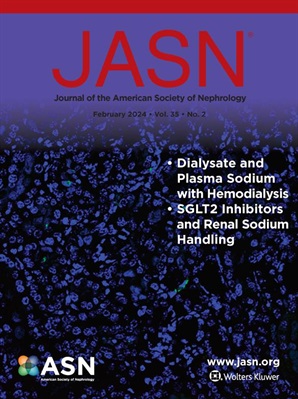Association of Clonal Hematopoiesis of Indeterminate Potential with Cardiovascular Events in Patients with CKD.
IF 10.3
1区 医学
Q1 UROLOGY & NEPHROLOGY
引用次数: 0
Abstract
BACKGROUND Patients with CKD are at higher risk of cardiovascular disease. Clonal hematopoiesis of indeterminate potential (CHIP) has been associated with cardiovascular disease in the general population, with a causal role observed in animal models. In the general population, the effect of CHIP is greater for somatic mutations in pre-defined CHIP driver genes other than DNMT3A (referred to as non-DNMT3A CHIP). We sought to assess the prospective association between CHIP and cardiovascular events in patients with CKD. METHODS CHIP was measured by high-depth targeted sequencing. The primary analysis tested the association of somatic mutations in non-DNMT3A CHIP driver genes with a composite cardiovascular disease endpoint of myocardial infarction, stroke, congestive heart failure, and peripheral artery disease in 5,043 patients with CKD in four prospective cohorts. Sensitivity analyses examined the effect of CHIP subtypes, race, baseline comorbidities, APOL1 risk alleles, and IL6R p.Asp358Ala genotype. RESULTS At baseline, patients had a mean age of 66 ± 12 years and eGFR of 43 ± 18 ml/min/1.73m2. CHIP was present in 24% of patients, with 13% of all patients carrying acquired non-DNMT3A mutations. Non-DNMT3A CHIP was associated with a 36% higher risk of the composite cardiovascular endpoint [95% confidence interval (CI), 6% - 76%]. Among composite components, non-DNMT3A CHIP was associated with a higher risk of stroke (HR 1.65; 95% CI 1.10 - 2.47). Baseline eGFR, diabetes status, or race did not alter the association of non-DNMT3A CHIP with cardiovascular risk. Those without genetically reduced interleukin-6 signaling (non-carriers of IL6R p.Asp358Ala) had worse disease (HR 1.46; 95% CI 1.17- 1.83, Psubgroup difference = 0.05). CONCLUSIONS In patients with CKD, non-DNMT3A CHIP was associated with cardiovascular disease with an effect size similar to that reported in the general population.不确定电位克隆造血与CKD患者心血管事件的关系
背景:CKD患者发生心血管疾病的风险较高。克隆造血不确定电位(CHIP)与一般人群的心血管疾病有关,在动物模型中观察到因果关系。在一般人群中,除了DNMT3A(称为非DNMT3A CHIP)外,CHIP对预定义CHIP驱动基因的体细胞突变的影响更大。我们试图评估CHIP与CKD患者心血管事件之间的前瞻性关联。方法采用高深度靶向测序法测定schip。初步分析测试了4个前瞻性队列中5043名CKD患者的非dnmt3a CHIP驱动基因体细胞突变与心肌梗死、中风、充血性心力衰竭和外周动脉疾病等复合心血管疾病终点的相关性。敏感性分析考察了CHIP亚型、种族、基线合并症、APOL1风险等位基因和IL6R p.Asp358Ala基因型的影响。结果基线时,患者平均年龄66±12岁,eGFR为43±18 ml/min/1.73m2。24%的患者存在CHIP, 13%的患者携带获得性非dnmt3a突变。非dnmt3a CHIP与复合心血管终点的风险增加36%相关[95%置信区间(CI), 6% - 76%]。在复合成分中,非dnmt3a CHIP与较高的卒中风险相关(HR 1.65;95% ci 1.10 - 2.47)。基线eGFR、糖尿病状态或种族没有改变非dnmt3a CHIP与心血管风险的关联。那些没有遗传减少的白介素-6信号(非IL6R p.Asp358Ala携带者)的疾病更严重(HR 1.46;95% CI 1.17 ~ 1.83, p亚组差异= 0.05)。结论:在CKD患者中,非dnmt3a CHIP与心血管疾病相关,其效应大小与在普通人群中报道的效应大小相似。
本文章由计算机程序翻译,如有差异,请以英文原文为准。
求助全文
约1分钟内获得全文
求助全文
来源期刊
CiteScore
22.40
自引率
2.90%
发文量
492
审稿时长
3-8 weeks
期刊介绍:
The Journal of the American Society of Nephrology (JASN) stands as the preeminent kidney journal globally, offering an exceptional synthesis of cutting-edge basic research, clinical epidemiology, meta-analysis, and relevant editorial content. Representing a comprehensive resource, JASN encompasses clinical research, editorials distilling key findings, perspectives, and timely reviews.
Editorials are skillfully crafted to elucidate the essential insights of the parent article, while JASN actively encourages the submission of Letters to the Editor discussing recently published articles. The reviews featured in JASN are consistently erudite and comprehensive, providing thorough coverage of respective fields. Since its inception in July 1990, JASN has been a monthly publication.
JASN publishes original research reports and editorial content across a spectrum of basic and clinical science relevant to the broad discipline of nephrology. Topics covered include renal cell biology, developmental biology of the kidney, genetics of kidney disease, cell and transport physiology, hemodynamics and vascular regulation, mechanisms of blood pressure regulation, renal immunology, kidney pathology, pathophysiology of kidney diseases, nephrolithiasis, clinical nephrology (including dialysis and transplantation), and hypertension. Furthermore, articles addressing healthcare policy and care delivery issues relevant to nephrology are warmly welcomed.

 求助内容:
求助内容: 应助结果提醒方式:
应助结果提醒方式:


